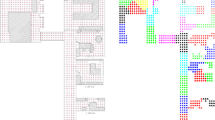Abstract
This paper presents a new approach to the outdoor road scene understanding by using omni-view images and backpropagation networks. Both the road directions used for vehicle heading and the road categories used for vehicle localization are determined by the intergrated system. There are three main features about the work. First, an omni-view image sensor is used to extract image samples, and the original image is preprocessed so that the inputs of the network is rotation-invariant and simple. Second, the problem of the network size, especially the number of the hidden units, is decided by the analysis of systematic experimental results. Finally, the internal representation, which reveals the properties of the neural network, is analyzed in the view point of visual signal processing. Experimental results with real scene images are encouraging.
Similar content being viewed by others
References
Fukushima Ket al. Neocognition: A neural network model for a mechanism of visual pattern recognition.IEEE Trans. on SMC, 1983, SMC-13(5).
Zhou Y T, Chellappa R A. A network for motion perception. InProc. IJCNN, 1990, pp.II841–851.
Atsumi Eet al. Internal representation of a neural network that detects local motion. InProc. of IJCNN, 1993, pp. 198–201.
Pomerleau D A. Neural Network Based Autonomous Navigation. InVision and Navigation: The CMU Navlab, Kluwer Academic Publishers, Boston, 1990.
Linggard R.et al. (ed.) Neural Networks for Vision, Speech and Natural Language. Chapman & Hall, First Edition, 1992.
Rumelhart D E, Widrow B, Lehr M A. The basic ideas in neural networks.Comm. ACM, 1994, 37(3): 87–91.
Neuralware Inc., Neural Computing/Reference Guide/Using Nworks of Professional II/Plus, 1991.
Yagi Yet al. Collision avoidance using omni-directional image sensor (COPIS). InProc. of ICRA, California, April 1991, pp. 910–915.
Author information
Authors and Affiliations
Additional information
Zhu Zhigang received his BS and MS degrees in computer science and technology from Tsinghua University in 1988 and 1991 respectively. Currently he is a Lecturer in the Department of Computer Science and Technology at Tsinghua University, while at the same time is a Ph.D. candidate in the same department. He is an IEEE student member and has published over 30 papers. His research interests include computer vision, pattern recognition and robotics.
Xu Guangyou is a Professor in the Department of Computer Science and Technoloy at Tsinghua University. He graduated from the Department of Automatic Control at Tsinghua University in 1963 and did some research work at Purdue University and University of Illinois. He has published a number of papers on computer vision and multimedia. He is the author of several books including Artificial Intelligence and Its Applications, Multimedia Technologies and Applications. He is a senior member of IEEE.
Rights and permissions
About this article
Cite this article
Zhu, Z., Xu, G. Neural networks for omni-view road image understanding. J. of Comput. Sci. & Technol. 11, 570–580 (1996). https://doi.org/10.1007/BF02951620
Received:
Revised:
Issue Date:
DOI: https://doi.org/10.1007/BF02951620




